
Many know Peru for Machu Picchu, one of the New 7 Wonders of the World, but not surprisingly, it boasts multiple wonders of the world on its soil. The mighty Amazon River flows through Iquitos, Peru and became one of the New 7 Wonders of the Natural World in 2012.
The Amazon River is something you must see in your lifetime! It is renowned for its astounding beauty, incredible biodiversity, and the vibrant cultures along its banks.
Located right on the Amazon River, Iquitos is a destination catered to adventurous travelers with a love for nature. Iquitos, the gateway to the Amazon, is the perfect addition to your Machu Picchu tour.
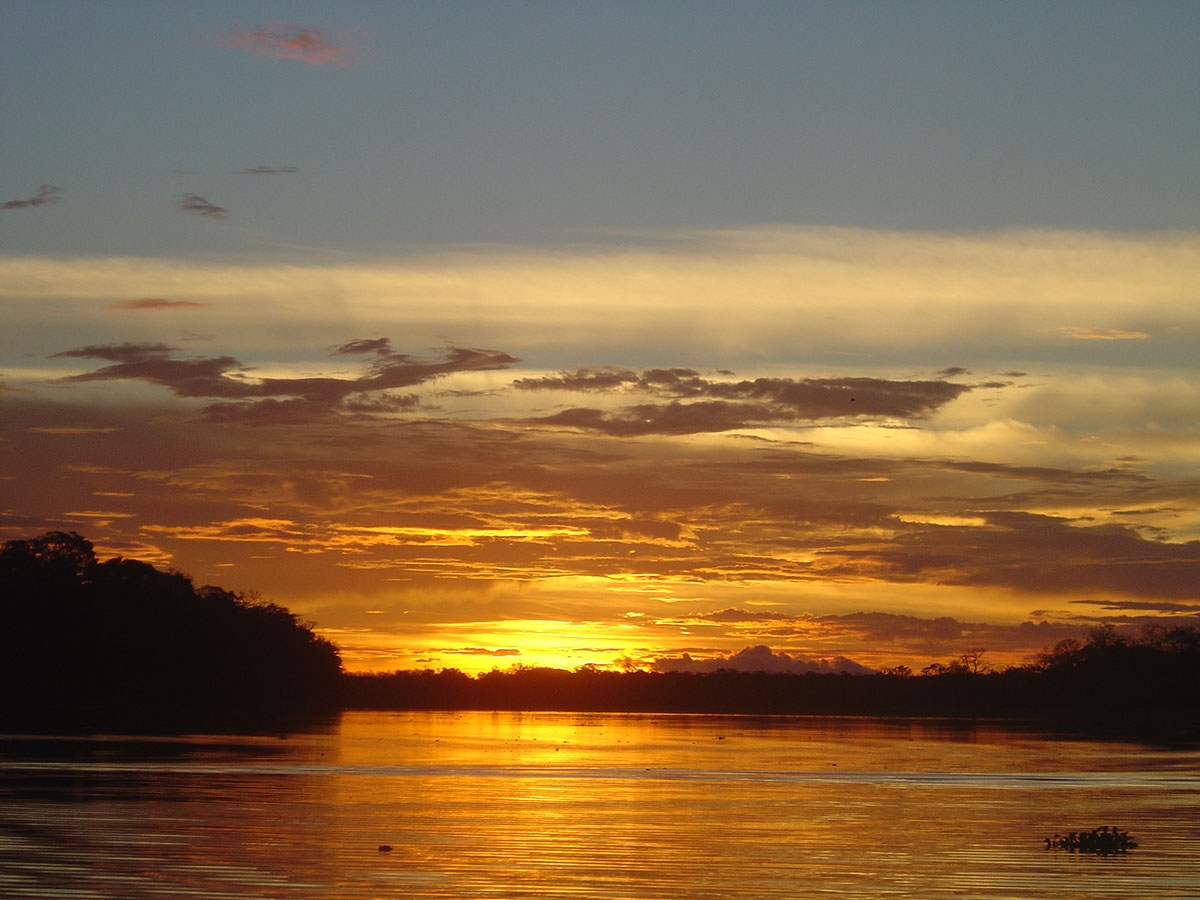
Spectacular sunsets can be admired over the Amazon River in Iquitos, Peru.
Known as the largest city that cannot be reached by road, getting to Iquitos feels like an adventure right from the start! Iquitos is one of the world’s most extreme towns on the planet due to its isolated nature despite it being Peru’s largest city on the Amazon River.
In Iquitos, you’ll find species which don’t exist elsewhere and unique experiences you can’t get anywhere else in the world. There’s a gourmet restaurant that floats down the Amazon River and even a Treehouse hotel where you can live out your childhood fantasy!
Luxury river cruises and rustic lodges provide the home-base for daily excursions that take you deeper into the heart of the Amazon rainforest in Peru. You can photograph lush jungle landscapes, spot wild animals in their natural habitat, taste Peruvian superfoods straight from the tree, and listen to the symphony of sounds around you on an Iquitos amazon tour into the Peruvian jungle.

A caiman is just one of the many animals you’ll see in Iquitos, Peru. Quistococha by tacowitte, used under CC BY-SA 2.0 / Cropped and compressed from original
Iquitos is located north northeast of Lima in the Loreto region of Peru along the Amazon river. This jungle city is the capital of the Peruvian Amazon and is deemed the gateway to the Amazon.
The Peruvian Amazon Rainforest is divided between northern and southern regions. Iquitos is part of the northern Amazon and is near to the Columbia and Brazil borders. Puerto Maldonado, in the southern Amazon, is in the Madre de Dios region of Peru and has lush biodiversity that thrives along the Madre de Dios river. The southern Amazon lies closer to the Bolivia and Brazil borders.

Map of Iquitos, Peru.
The Amazon River is located in South America and actually originates from a glacier in Colca Canyon, Peru. It’s just south of Iquitos, where the Marañón River and the Ucayali river converge, that the Amazon River first shows up on a map. From there, it flows eastward. The Amazon River runs through Peru, Ecuador, Columbia, Venezuela, Bolivia, and out through Brazil into the Atlantic Ocean.

The Amazon River runs from Iquitos, Peru to Brazil.
How do you get from Lima to Iquitos then if it’s not accessible by road? Flights from Lima to Iquitos depart daily making the 640 mile journey in just under 2 hours. Locals traveling the region use cargo ships called lanchas to get from town to town by way of the river. Adventurous backpackers can also take the several day journey by cargo boat to witness remote cities along the Amazon river. For this off the beaten path travel route, basic Spanish is a must as well as wiggle room in your travel schedule for frequent cargo ship delays.

The Amazon River from above the clouds. clouds-23 by Apollo, used under CC BY-SA 2.0 / Cropped and compressed from original
Yes. Iquitos is a safe place to travel with violent crime being largely unheard of. Around the Belen neighborhood and market pickpocketing can occur. It’s good to always be aware of your valuables and leave more expensive items tucked safely away in your hotel safe while exploring the city.
I asked Travel Advisor Adam Laughter what he had to say about safety in Iquitos. He said, “there are some sections of the Malecon Tarapaca that show the reality of poverty in Iquitos as you see communities of shacks down by the river. Depending on the tourist this could be a nice wake-up call or a big turn off. The section right down the street from the Plaza de Armas was decently safe at night but I wouldn’t go much farther down to the end after 7PM.”
The biggest dangers to your health in Iquitos would be from mosquito bites, or parasites due to improper food or water handling. Wearing repellant, drinking filtered water, and eating at reputable restaurants will be the best way to avoid any health bumps along the way. Read more about safety in Peru here.
Sub out Puerto Maldonado for Iquitos in any one of our customizable itineraries below. Or talk with one of our expert Travel Advisors to completely customize your Peru trip from scratch.
Machu Picchu & Jungle Adventure – This 9 day itinerary takes you to the famous Machu Picchu ruins and into the jungle.
Mystical Amazon & Andean Highlights – From Peruvian jungle to mountains to lakes, this 11 day itinerary gradually acclimatizes you as you explore the biodiversity of Peru.
Cross the Andes to the Amazon – This 12 day itinerary takes you from Lima to Arequipa and Colca Canyon to Machu Picchu and onwards to the Amazon Rainforest.
Discover Peru – This 16 day adventure takes you to all the must-see destinations in Peru! Get a taste of everything that Peru has to offer!
Visit our complete destination guide for the Peruvian Amazon Rainforest for more info about Iquitos, Puerto Maldonado and other exciting jungle destinations!

A blue and yellow macaw is a species found in Iquitos. Photo by kuszapro, used under CC BY-SA 2.0 / Cropped and compressed from original
A multi-day Amazon experience is the best way to see wildlife in a sustainable way. Staying at a jungle lodge or taking a luxury river cruise allow you to view different aspects of the jungle in their natural habitat. Look for a lodge or cruise that use sustainable tourism practices, why? Because protecting nature helps ensure you and the animals have a better experience. While it may be tempting to hold a sloth or macaw, that’s not where those animals truly belong. Unfortunately, paying money and attention to this practice ultimately brings harm to the place you’ve come so far to see.
Deeper exploration promotes animal wellbeing, supports local communities, and protects the natural environment. If you want a true Amazon experience, you should give yourself more than one day in Iquitos to experience the Peruvian Amazon rainforest.

A monkey hangs from a tree in Iquitos, Peru. Photo By Alexandra Aguinaga of Peru For Less.
All lodges will take you from Iquitos city to their lodge on a boat ride. This ride usually takes between 2-4 hours depending on the location of your lodge. Iquitos is nick-named the gateway to the Amazon because Iquitos city is the starting point for explorations.
Treehouse Lodge Peru is a luxury Eco-property in Iquitos. Perfect for those looking to snap photos of some cool looking birds because your room is a treehouse built within the tree canopy. You’ll feel right at home amongst the toucans and monkeys that also call the Amazon home. Solar panels provide electricity making this a peaceful respite for anyone looking to disconnect.
This lodge is for anyone daydreaming of sleeping in a treehouse. Experience the real Amazon with creature comforts like gourmet food, experienced guides, and panoramic jungle views.
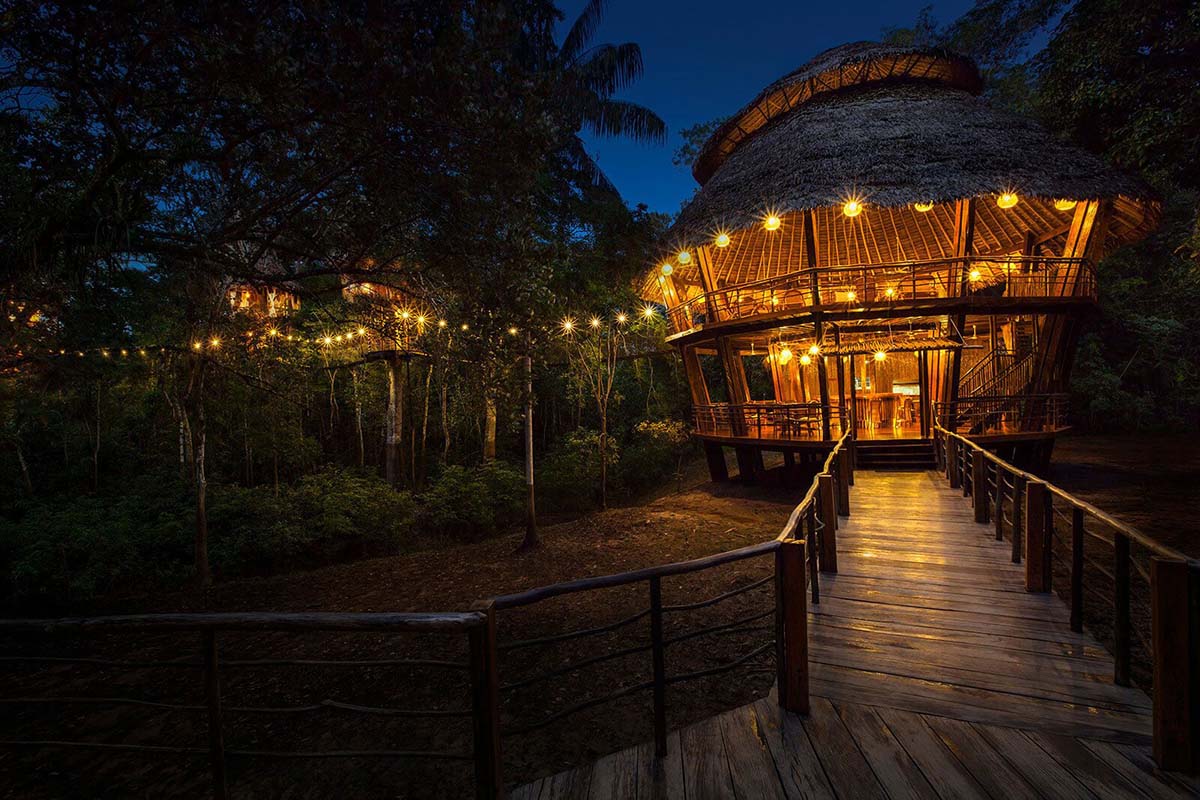
Treehouse Lodge has all 12 Treehouse rooms built above the trees. Treehouse Lodge by Treehouse Lodge, used under CC BY-SA 2.0 / Cropped and compressed from original
Tapiche Jungle Reserve isn’t your ordinary touristic Lodge experience. Here they do the real work of preserving endangered species susceptible to poaching. Located a days boat ride from Iquitos, the long journey is worth it! Being more remote allows for greater chances of spotting those animals you’re wanting to see during excursions. This lodge is for anyone wanting an authentic off the beaten path eco-friendly Amazon experience.
“We don’t domesticate or manipulate the animals in any way, so visitors are seeing animals undisturbed in their natural habitat. Because of this, we can’t guarantee specific sightings, but our jungle is healthy, and there is always something great to see.” – Deborah Chen of Tapiche Jungle Reserve.
Amazon Yarpa River Lodge is a stunning solar-powered lodge located about a 4 hour boat ride from Iquitos city. Yarpa River Lodge partnered with Cornell University and houses a field research center dedicated to conservation and the discovery of medicinal compounds. Their dedication to conservation means you’ll get access to top-notch guides and better chances of spotting animals on the protected reserve.
The closer of Amazonia Expedition’s two Iquitos Amazon Tour options. Tahuayo Lodge is found just before the protected Tamshiyacu Tahuayo Reserve. This reserve spans 1,621.94 sq miles southeast of Iquitos and is about 4 hours by boat from Iquitos city. Powered by solar energy, conservation here does not mean sacrificing comfort. Thrill seekers and nature enthusiasts alike will love the zipline ride 90 ft above the jungle canopy included in your stay!
“The Amazon has biodiversity because it is a complex mosaic of different ecosystems.” – Tahuayo Lodge
Ceiba Tops Luxury Lodge is a luxury resort located about 1.5 hours outside of Iquitos. Here you’ll get all the creature comforts like hot water, air conditioning, wifi and even a pool! This is the place for anyone wanting to experience all the wonders of the Amazon without getting too far off the beaten path.
Amazon Rainforest Tours:
Iquitos does not mean “roughing it” by any means when you can do it in style and comfort with a luxury Iquitos river cruise.

Amazon river cruises like the Delfin I in Iquitos, Peru is a great way to experience the Amazon. Delfin I by Delfin Amazon Cruises, used under CC BY-SA 2.0 / Cropped and compressed from original
Experience the Amazon in complete opulence on any one of Delfin’s three luxury river cruises down the Amazon river. The first Realis & Chateaux cruise property to exist, it provides exceptional service, attention to detail, gourmet food, and expert adventure guides. Its associated non-profit Kuyapa offers aid to in-need communities in the Andes and Amazon region meaning that luxury and sustainability can go hand in hand. Focusing on every single detail, Delfin is as luxurious as it gets in the Peruvian Amazon.
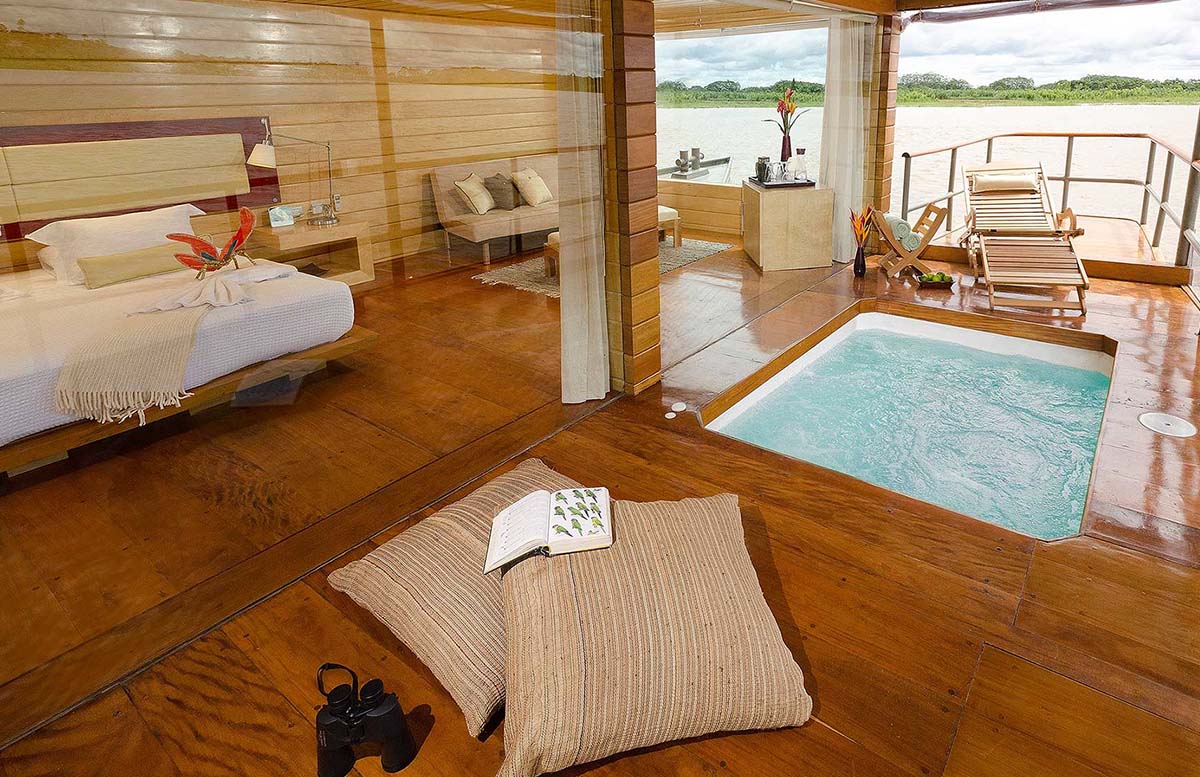
An inside view of the luxury accommodations on Delfin Amazon Cruises. Delfin I by Delfin Amazon Cruises, used under CC BY-SA 2.0 / Cropped and compressed from original
Sail down the Amazon River like an explorer of old – with all the modern fixings for a very comfortable ride. Jungle Experiences offers 3 cruise options available to suit every type of traveller. As the winner of the 2019 World Travel Award for Leading River Cruise Company you’ll enjoy daily excursions, delicious food, luxurious accommodations, all with a moving panoramic view of the Amazon rainforest.
Lodges and luxury cruises are all inclusive multi-day experiences. You can still experience a lot staying in Iquitos city if you’re tight on time. Here are some of our top picks for all star levels.
The 5-Star Doubletree by Hilton Iquitos is a luxury option right in Iquitos city. It has an impressive rooftop pool and spacious air-conditioned rooms. Don’t forget to try the deliciously prepared food (with gluten free and vegan options available) at the onsite Manoa Café Restaurant.

The rooftop pool at the DoubleTree by Hilton in Iquitos, Peru. DoubleTree by Hilton Iquitos by DoubleTree by Hilton Iquitos, used under CC BY-SA 2.0 / Cropped and compressed from original
The 4-star Samiria Jungle Hotel Iquitos, Peru is the largest hotel in Iquitos. All 71 rooms are equipped with air conditioning, a minibar, hairdryer, and Wifi. The buffet breakfast and huge outdoor pool make this a great place to make your homebase while exploring the city.
The Epoca Boutique Hotel is a UNESCO heritage building built in 1902 during the Iquitos rubber boom. All 12 of the quaint rooms have air conditioning and Wifi.
The hotel La Casona Iquitos, Peru is a cozy 2-star option built in a renovated 20th century building. With comfy beds, an outdoor pool, air conditioning or fans, and private bathrooms it’s a great option in Iquitos city that doesn’t break the bank.
In short, there is no bad time to see the Amazon River in Peru! The Amazon thrives all seasons of the year so travelers can rest assured that no matter when you go to Iquitos, you’ll be likely to spot animals and plants you’ve never seen before. All in all, the best time to visit Peru depends on which other regions you plan to visit, so it may be better to plan your Peru trip around the best time to visit Machu Picchu unless you have a very specific species that you want to spot or are looking to avoid hiking on your Amazon excursions.
Iquitos has two main seasons: wet and dry. Each season has it’s pros and cons but regardless of the time of year you go, you’ll watch in awe as the animals adapt to their current landscape.
The wet season or high water season (December to May) tends to have a slight drop in temperatures with higher humidity than the dry season. It is the best time to see plants flowering and has trees abundant with fruits from January – April. Bunches of monkeys and various birds gather to eat from their branches. Wet season also coincides with birthing season for many animals. The dry season or low water season (June to December) tends to have hotter temperatures but with less rain and fewer pesky insects. Hikers should opt for the dry season since more land is exposed from the receding water levels.
The rains from the wet season (December to May) raise the water levels as much as 40 feet (12 meters), flooding the area. These floods give boat access to higher parts of the canopy and more remote parts of the Iquitos jungle. Wet season has more boat excursions making it suitable for anyone with trouble walking for long periods of time.
“I personally love high water season,” says Diana Moreano, the Sales & Reservations Executive at Delfin Cruises. “Since everything is flooded you get to go so much further into the national reserve onboard our speedboats. You are right next to the treetops, and therefore closer to the animals, and get to places you wouldn’t be able to get walking. There are so many little nooks where you will only cross paths with a local fisherman in a canoe if any.”
On the flip side, the dry season (June to December) lowers the water levels. This makes drinking spots and animal feeding areas more concentrated to areas where the water remains – you’ll just have to walk a bit to get there.
“Low water season [June through October] is my husband’s favorite season,” says Moreano. “Because you get to be a little bit more active since the rainforest isn’t flooded, overall you will be doing the same activities as high water season [December through May] just with a little bit more of walking.”
Read more about the luxury river lodging aboard Delfin Amazon Cruises.
The San Juan Festival celebrates Saint John the Baptist, the patron saint of the Amazon, every year during the dry season from June 22nd to June 25th.
December holidays fall within the wet season and bring a surge of travelers with boosted hotel rates.
If planning an Iquitos to Machu Picchu experience around a holiday, be sure to book several months in advance for better chances of availability at your preferred hotel or lodge.

A white-throated toucan resting in a tree in the Amazon Rainforest in Peru. White-throated Toucan | Piapoco de Garganta Blanca (Ramphastos tucanus cuvieri) by Fernando Flores , used under CC BY-SA 2.0 / Cropped and compressed from original
The weather in Iquitos is consistent year round. The daily high is between 90°F (32°C) and 88°F (31°C) and low between 69°F (20°C) and 71°F (22°C).
The wet season, or high water season from December to May, has an average of ~10.3 inches of rain. The dry season, or low water season from June to November, has an average of ~7.6 inches of rain.
When it comes to visiting Iquitos, the experts all say to plan your trip around your preference for boat or for walking excursions!
“The “rainy” season starts in December/January until April more or less. So I would recommend visiting Iquitos after April,” tells Gabriella Padilla, a Peru for Less employee who was born and raised in Iquitos. “[But] if you want to be part of a real/heavy rain you can go ahead and visit Iquitos in that season too. However, it’s important to mention that we have rain the whole year, but especially on the listed months.”
Deborah Chen from the Tapiche Jungle Reserve told me that “during a “normal” high water season, [animals] can be observed via boat, whereas during an average low water season, visitors would need to spend a lot [more] time on foot trekking through the jungle in order to see them.”
Adam Laughter, an Expert Travel Advisor at Peru For Less, says about his trip to Iquitos via lancha:
“I did experience a little rain on my trip to Iquitos in late April and honestly, it was a highlight for me. There is something so unique about witnessing a downpour in the Amazon and watching it hit the river.”
“The beautiful thing about the Amazon,” says Laughter, “is that you can visit it anytime of the year and still have a fantastic experience. My preferred month to visit is in March or April since the waters are still high enough for doing more visits by boat. This time of year also matches up nicely for preferred weather in other destinations like Lima and Machu Picchu.”
Exploring the Amazon Rainforest in Iquitos is an experience you’ll never forget. The thick jungles in Peru make the perfect backdrop to a honeymoon adventure, solo soul-searching experience, or family-friendly way to learn about nature and the biodiversity of the Peruvian rainforest. There are numerous things to do in Iquitos city itself either before or after heading to your Lodge or Cruise.
Activity in Iquitos revolves around the city’s Plaza de Armas. It’s the perfect spot to enjoy a leisurely stroll, grab a bite to eat or buy keepsake souvenirs. A stone statue commemorating the soldiers of the War of the Pacific (1879-1883) is the centerpiece of the tree-filled plaza. Matriz Church, also known as Iquitos Cathedral, on the western corner features neo-Gothic architecture and a tall bell tower. Only 20-30 minutes from the Francisco Secada Vignetta Iquitos International Airport you’ll certainly have time to see this on your Amazon adventure.
Casa de Fierro, or House of Iron, was constructed at the end of the 19th century during the rubber boom. Covered in full by silver-hued metal sheets, its structure – built by Gustave Eiffel, boasts a second story wrap-around balcony, several exterior columns, and a distinct red roof. The building is one of the best preserved examples of civil architecture in Peru and an iconic historic site in Iquitos.

The Casa de Fierro in Iquitos, Peru. Photo by Deb Dowd, used under CC BY-SA 2.0 / Cropped and compressed from original
The Tarapaca Malecon is a scenic promenade overlooking the Itaya River just a few blocks from the city’s main plaza. From this riverfront pathway filled with gardens and historic monuments, you can take in spectacular views of the surrounding Amazon tributary. You’ll see rich green foliage and houses of the city’s Belen neighborhood built on stilts over the water. Locals and travelers gravitate to the vibrant energy of this part of Iquitos. It is replete with cafes, restaurants, bars, and beautiful mansions constructed at the height of the rubber boom. Head here also to experience the lively nightlife in Iquitos.
“I stayed at a hostel right on the Malecon Tarapaca and the views at sunset were really nice.” Tells Adam Laughter, “The Plaza de Armas (where the Doubletree is located) is only a 2 blocks up from the Malecon so it’s easy to access. It’s pretty small so it doesn’t take long to walk and again, great for river views.”
Laughter also advises a sunset boat ride on the Itaya River. “Once 5PM hits you can start to see lots of small boats take off from the port area by the Malecon Tarapaca with the goal to see the sunset over the river outside of town. The ride is only about an hour or so but definitely a nice experience.”
Location: One block east of Plaza de Armas; Malecon extends about 5 blocks along the riverfront

The Malecon Tarapaca offers gorgeous views and local snacks for sale. Family on Malecon by Alan Kotok , used under CC BY-SA 2.0 / Cropped and compressed from original
Activity at Belen Market begins early and offers travelers an authentic look at life in Iquitos. Explore a labyrinth of stalls piled high with exotic fruits, freshly caught river fish, and jungle herbs. Also for sale are jungle-grown seeds and roots along with bottled oils used for healing and shamanistic rituals. It’s best to bring small notes of Peruvian Soles to make your market buys and bartering is common practice.
“At the end of the Malecon Tarapaca and maybe 4 or 5 more blocks inland you can access the Mercado de Belen which is one of Iquitos more popular markets,” Says Travel Advisor Adam Laughter. “It’s important to know this is a morning activity and travelers should go with very little valuables. There is a lot of animal trafficking in Iquitos and they will see a fair amount of exotic animals here. Monkeys are also trained to pickpocket people so keep an eye out. Once you are in the market neighborhood you can also take a little boat ride down what they call the “Venice Loretana”.
Location: North-eastern section of Iquitos along the river
Pilpintuwasi, an animal rescue center and butterfly farm, is a paradise located 15 minutes by boat outside of Iquitos city. A wide variety of butterflies and animals that were once poached from the forest to sell on the black market live here. Now, the team is working to rehabilitate the animals and give them a much happier life.
Adam Laughter recommended this spot to me saying:
“This was a cute rescue center that is not too far of a boat ride from the main port. The English speaking guides are volunteers and typically from other countries so they all had their own unique stories. This was by far one of my favorite days and the “Animal Orphanage” as she calls it, is home to plenty of rescued animals. The nice part about this is that they are dedicated to taking care of them for rehabilitation and you are not allowed to hold/touch any of the animals. This is unique for Iquitos as I would say the average “rescue center” is created for tourism purposes not rehabilitation.”

Butterflies, like these two, are found plentifully in Iquitos, Peru. Dryadula phaetusa (Nymphalidae: Heliconiinae: Heliconiini) by Dr. Alexey Yakovlev, used under CC BY-SA 2.0 / Cropped and compressed from original
Monkey Island (Isla de los Monos in Spanish) is an island about 45 minutes outside of Iquitos city. Here staff are devoted to rehabilitating monkeys – an entire Island of them! Unfortunately, not all poached animals are able to be released back into the wild. Monkey Island allows for travellers to learn about the effects of wildlife tourism. Friendly monkeys might even jump on your shoulder!
Location: Condamine 416, Iquitos
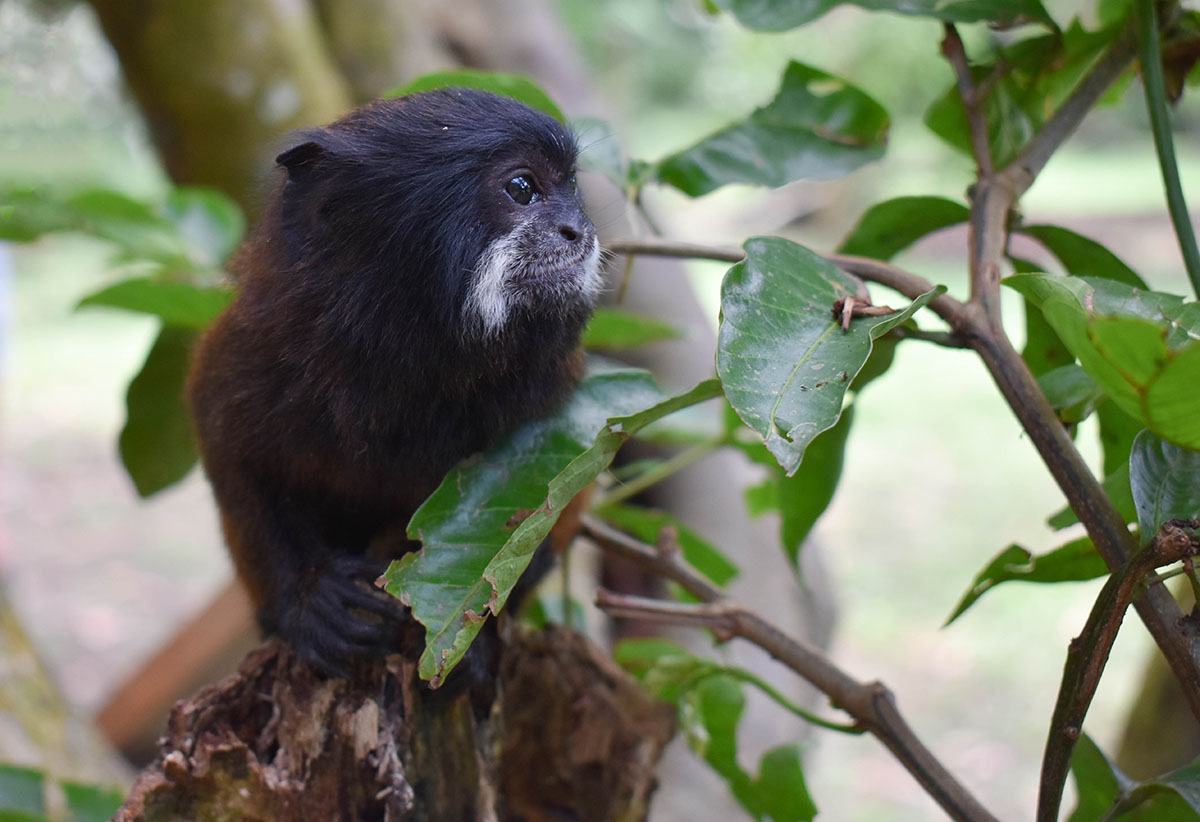 A white moustached monkey from Monkey Island in Iquitos, Peru. Photo By Alexandra Aguinaga of Peru For Less.
A white moustached monkey from Monkey Island in Iquitos, Peru. Photo By Alexandra Aguinaga of Peru For Less.
The Amazon Rescue Center also goes by the name The Manatee Rescue Center. It rescues, rehabilitates, and releases manatees and other endangered wildlife in Iquitos. It makes for a perfect way to see these seacows up close while also supporting the protection of this endangered species.
Location: Carr. Iquitos-Nauta Km 4.5, San Juan
The Amazonian Indigenous Cultures Museum highlights the history and culture of indigenous populations from all over the Amazon Basin. Housed in the small two story building, the well curated museum showcases ceremonial relics, clothing and hunting tools.
Location: Malecon Tarapaca 332; Admission S/.15
The Amazonico Museum displays pottery, faded paintings, and ceremonial relics from local tribes who have little to no written history. There are also large bronze statues depicting indigenous Amazon people. The museum is housed in the former town hall building built in 1863.
Local jungle flavors intertwine with expat and Peruvian influence in Iquitos. You’ll find detox juices with fruits you’ve never tasted before, and catches of fish found exclusively in the Amazon River. Check out our top restaurant recommendations for Iquitos.
Al Frio y Al Fuego is the only restaurant in the world that floats down the Amazon river! Take a boat to the two story floating restaurant for a romantic dinner. Taste amazonian flavors, exotic fruit sauces, and elaborate cocktails while you float down the Amazon river. Veggie options available.
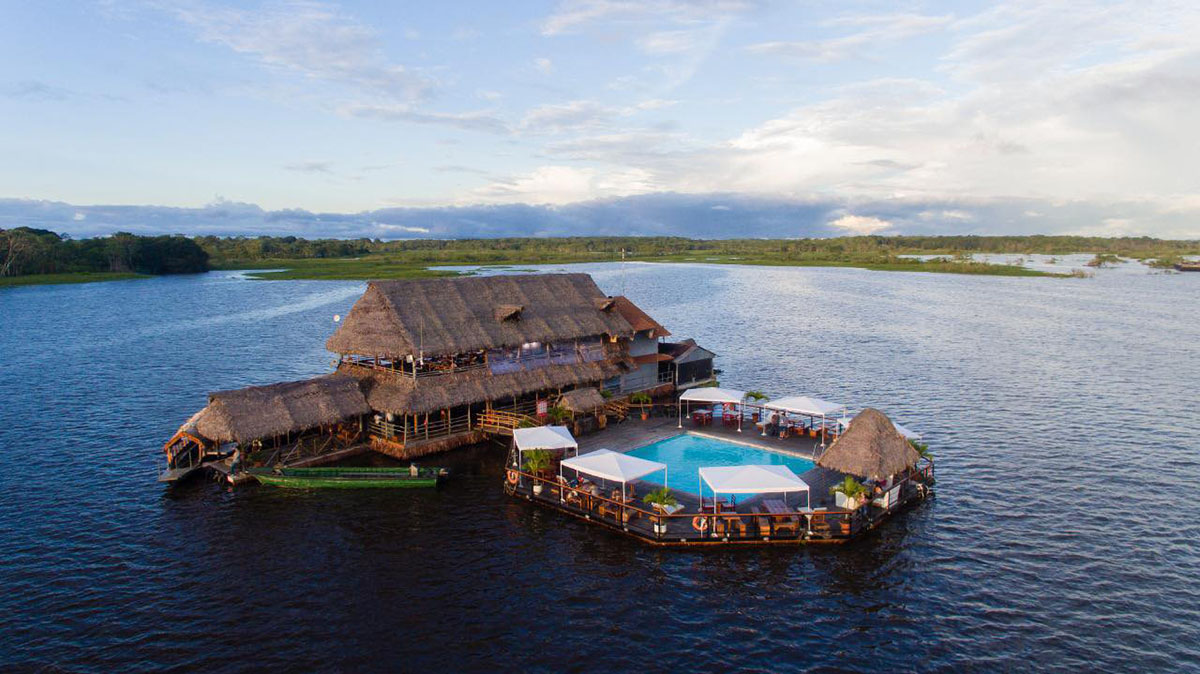
Al Frio y Fuego is a floating restaurant on the Amazon River in Iquitos, Peru. Al Frio y Al Fuego Restaurant by Al Frio y Al Fuego, used under CC BY-SA 2.0 / Cropped and compressed from original
For anyone wanting to taste the Amazon, you have to take a seat at the Gran Maloca. Amazonian river fish like Paiche, delicious fruit juices, and various Amazon flavors can be had inside. Outside, enjoy a gorgeous colonial building adorned with the classic tile-work of Iquitos.
El Mijano is a great place to try out Peruvian and Peruvian Amazon cuisine while immersing yourself into its lively culture. While you dine, watch as dancers perform typical dances of the region to live music, it’s an experience you’ll never forget!
Karma cafe gets endless rave reviews speaking to its cozy atmosphere, diverse menu, and great coffee! Live music can be enjoyed alongside a meal most nights, while Peruvian cocktails can be had every day, especially at happy hour. This popular place tends to get busy so give yourself extra time – the wait is worth it! Veggie and vegan options available.
Restaurante Fitzcarraldo is a restaurant in tribute to Werner Herzog’s 1982 film Fitzcarraldo. Taking place and filmed in Iquitos, this restaurant houses original props, movie posters, and of course delicious food. You can head here for breakfast, lunch, and dinner or head to their bar to experience the nightlife in Iquitos, Peru.
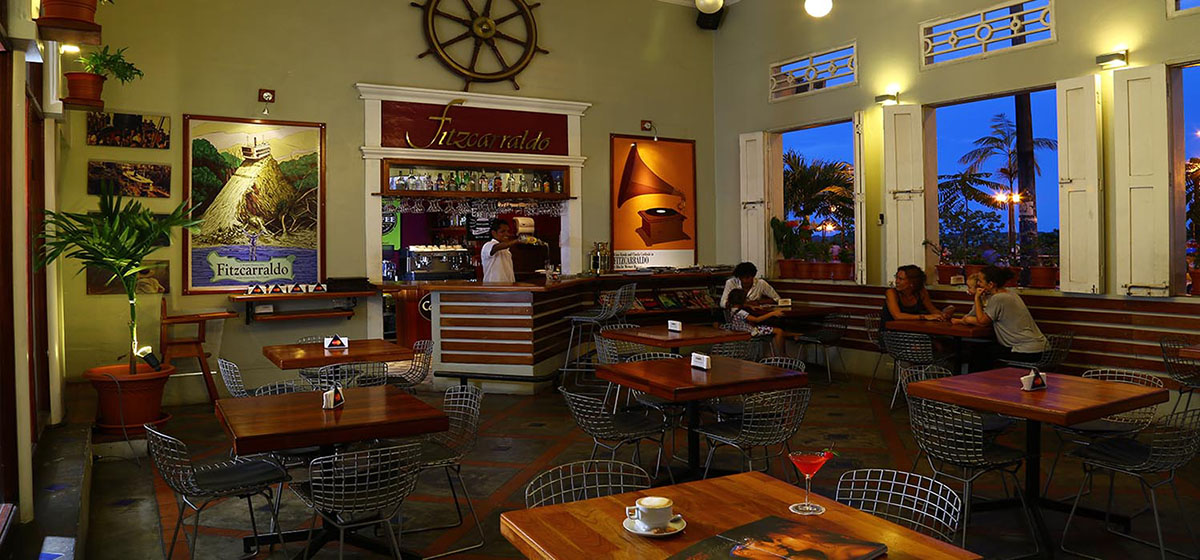
Restaurant Fitzcarraldo houses props from the 1982 Werner Herzog film Fitzcarraldo based in Iquitos, Peru. Restaurante Fitzcarraldo by Restaurante Fitzcarraldo, used under CC BY-SA 2.0 / Cropped and compressed from original
Ikiitu is featured on the popular 2020 Netflix Travel docuseries Down to Earth. Zac Efron and health guru Darin Olien would recommend this as a spot worth trying an Amazon dish like ceviche or suri at.

Suri are fried white worms. Often served on a skewer, these are a popular jungle snack. Suris al palo by Carlos Daniel Gomero Correa , used under CC BY-SA 2.0 / Cropped and compressed from original
I asked Gabriela Padilla, a Peru For Less employee who was born and raised in Iquitos for her top restaurant recommendations. Here’s what she told me:
“Definitely the best typical food can be found at Al Frío y Al Fuego (for me the best restaurant in Iquitos Peru), Gran Maloca and El Mijano. These three are in the city and the first one requires a small boat ride.”
To help you pick what’s best to eat off the menu at any of these restaurants, I’ve asked Adam Laughter, a Travel Advisor at Peru For Less to explain some ingredients you may not recognize. Having travelled to the Peruvian Amazon more than just a handful of times, he’s an expert when it comes to the local cuisine.
A gigantic Amazon river fish that is steamed, fried, grilled or any other way of cooking you might think. It’s a local delicacy and something you can only find in the Amazon.
Another popular river fish that is similar to the Paiche but tends to be cheaper. They also make ceviche out of doncella and paiche (not my highest recommendation).
This is a popular brand of popsicles for the jungle and they have all of your fantastic fruit favorites. Like: camu camu, aguaje, cocona, pijuayo, guayaba, chirimoya, and uvilla.
Aguaje is a specific fruit pretty widespread in the northern Amazon. Not my favorite in terms of eating by itself but the ice cream version is amazing. You can see tons of vendors on the streets selling aguaje (they peel it first), so this is a common snack for them.

Aguaje is a fruit from the Amazon Rainforest and makes a delicious ice cream. Aguaje, the tree of life by Marca PERÚ, used under CC BY-SA 2.0 / Cropped and compressed from original
This is taken from the heart of palm leaves and has an amazingly light/feather feeling. It doesn’t have tons of taste but with the right dressing it will feel like a jungle luxury.
Now out of personal preference (maybe bias) the cecina and chorizo in Iquitos is not the best you can find in all of Peru but this is still a staple food of any jungle town. Cecina is like a smoked/cured thick bacon that is accompanied with mashed green plantains (tacacho). Patacones are fried/mashed green plantains that are easily considered as the jungle version of a thick waffle fry. It typically comes with a nice side of cocona salsa.
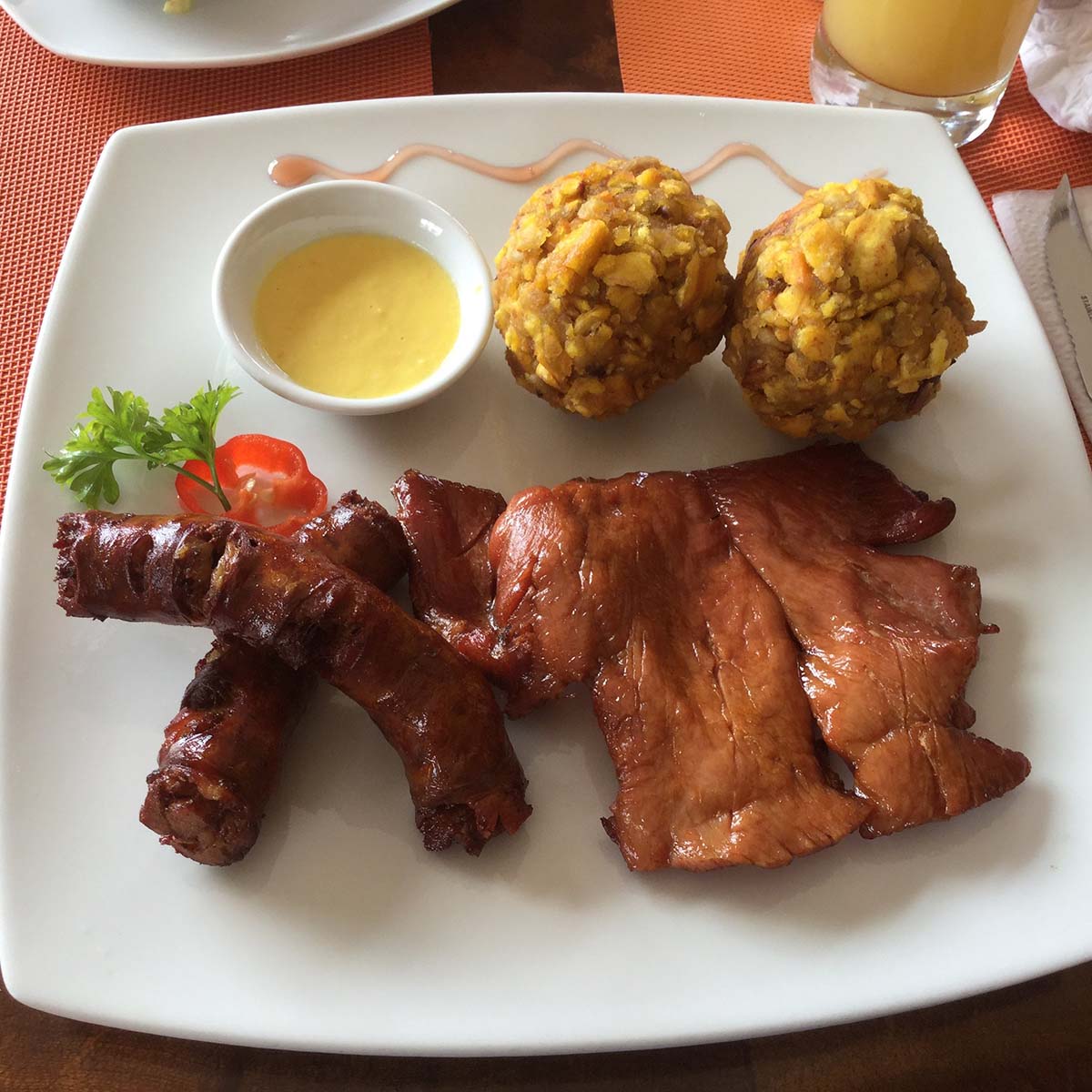
Tacacho con Cecina is pork and mashed plantains, often served with patacones deep fried plantains. “tacacho”” by vivir_de_ilusiones, used under CC BY-SA 2.0 / Cropped and compressed from original
This is a jungle favorite and combines seasoned rice, chicken leg, half an egg and half of an olive this is then wrapped in a Bijao leaf. It is cooked in the leaf and the slow cooking process brings the flavors out nicely.
Gabriela Padilla says this about her favorite Iquitos foods:
“I would say my favorite food from Iquitos is the “Tacacho con Cecina” and “Juane”, too. But there are many options such as “Inchicapi” (soup), roast fish (fish from the river tastes so different). The ceviche made with paiche (river fish) is a delicious dish, too.”
Peru Tours:
Life in the Amazon rainforest takes many forms below, within, and above its leafy green canopy. It is home to big-eyed monkeys rustling amid trees, bright bird species, stealthy river creatures and other ecological oddities. In northern Amazon tributaries, pink river dolphins are but one unique animal that can be spotted in the national parks surrounding Iquitos. Keep your eyes peeled and camera in hand because seeing these rainforest residents in their natural habitat may well be the highlight of your jungle adventure. Jungle lodges surrounding Iquitos are the perfect hub for convenient access to remote jungle reserves.
Amazon River Turtles During the dry season river turtles lay their eggs in the exposed sandy beaches making this a great time to spot them.
Pink River Dolphin -The biggest of all river dolphins, these rose colored creatures flush brighter when excited. Calves are born during high water season between July and September but with little luck you can spot these creatures year-round.
Three-Toed Sloths – Head to Iquitos during the wet season for the best chance at viewing these creatures. Why? The elevated water levels bring you up to their level.
Jaguar – Pacaya Samiria National Reserve is located 115 miles southwest of Iquitos. Here you can find this sought after Amazonian predator. Jaguars are night active so those wanting to spot these elusive creatures should plan their Iquitos itinerary accordingly. With a lot of luck you can spot these creatures year-round.

Jaguars can be spotted in Iquitos, Peru. Quistococha by tacowitte, used under CC BY-SA 2.0 / Cropped and compressed from original
Red-Bellied Pirhanas – Piranhas are native to the Amazon River and can be caught year-round so long as you know where to look. Most Lodges in Iquitos have piranha fishing excursions included in their itineraries. Learn to catch one, cook it, and if you desire, eat it later at your Lodge.
Macaws, Hoatzin, Toucans, more! – The jungle canopy is a symphony and birds of all types can be seen and heard from the treetops year-round. The best season for birding in the Iquitos jungle is in August and November – December.
For more detailed information, check out more animals that can be seen in Northeastern Peru.
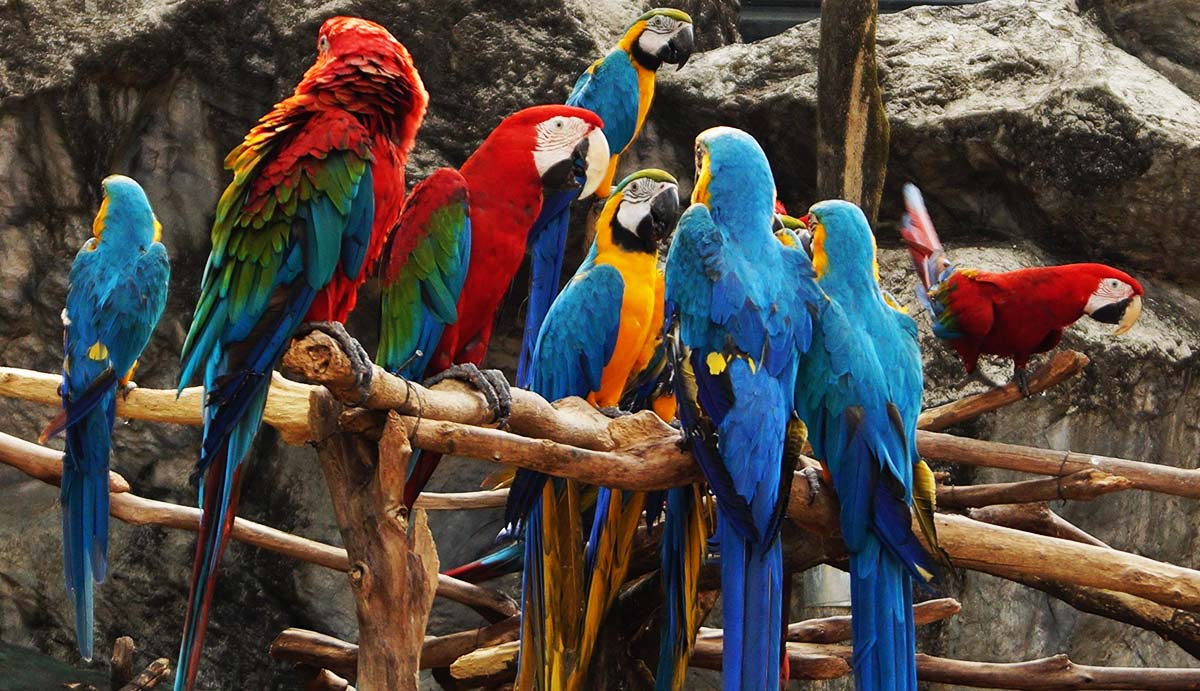
Tropical birds, like these macaws, are easy to spot on an Iquitos Amazon tour. blue and gold Macaw – ara ararauna by MARCIN CZERNIAWSKI, used under CC BY-SA 2.0 / Cropped and compressed from original
Bear in mind that when doing boat excursions, the reflection of the sun on the water makes your whole body susceptible to sun exposure. Always carry extra sunscreen to re-apply throughout the day. If you’re like me and don’t usually wear hats, you can always pick one up cheaply in Iquitos city before heading to your lodge and gift it to someone before you leave.
Eco lodges will provide you with water refill stations but often the cups can be small. Bring your favorite water-bottle to refill throughout your trip. This will keep you hydrated and cut your plastic use during your Iquitos vacation!
What do you wear to Iquitos? Loosely fitting, breathable and quick-drying fabrics are perfect for Peru rainforest tours. Long sleeves and long pants are best to keep skin covered. Mosquitos tend to be attracted to black so avoid tight fitting leggings or dark clothes. Earth tones tend to be better for animal viewing as it acts like camouflage. Opt for synthetic fabrics instead of cotton since synthetic dries faster.
Lodges in Iquitos will provide rain boots for going on tours through the jungle. But, you should still come prepared with good hiking shoes. Bring along a pair of comfy shoes too for lounging around the Lodge after excursions.
In Iquitos, there’s always an opportunity to jump into the river, swim under a waterfall, or simply lounge in the sun. Your luxury cruise may also have amenities like a hot tub which you’ll want your bathing suit for.
Winter clothes can seem out of place in the Amazon, but a scarf comes in super handy for many reasons. Use a scarf to cover exposed parts of your body and as a mosquito swatter. Also useful as a makeshift towel for impromptu river jumps or rolled up as a pillow for the short plane ride from Lima to Iquitos.
A small bag is the perfect companion for an Amazon tour. Fit your water-bottle, camera, bug spray, sunscreen, and binoculars in one place. Don’t forget little essentials like lip-balm, bandaids, or hand sanitizer by keeping them in your daypack all times.
Before heading to Peru you should always speak with a doctor about what vaccinations or medications you may need for your trip.
A Yellow fever vaccination is recommended by the CDC before for your Amazon adventure. Though you will not need to provide documentation of the vaccination upon entering Peru, it’s best to carry a copy with you just in case.
Antimalarials may be prescribed by your doctor as Iquitos is located in a high malaria zone. These often need to be taken before your arrival to the area and throughout your time there.
In case of any intestinal bugs along the way, bring medicines you may need for nausea, indigestion, or diarrhea. Note: You can always grab these over the counter pills at any pharmacy in Peru – just look for the green + symbol.

For more information about the yellow fever vaccine visit the CDC website. Infographic by Peru For Less.
The Amazon rainforest has a long history of human settlement, which dates well before European explorers arrived to South America. Many of these indigenous tribes like the Maijuna lived along the river-ways and survived by hunting, fishing, and growing crops in fertile floodplains. Archaeological evidence of the oldest known Amazonian settlement dates back an estimated 11,000 years.
While the Amazon covers more than 60 percent of Peru, the sparsely populated region houses only 5% of the country’s population. Some indigenous communities reside in main jungle cities, like Iquitos, Pucallpa, and Puerto Maldonado. Other communities live in remote Amazon regions only accessible via boat ride.
The Yaguas are an indigenous group inhabiting an expansive region, from the northeastern jungle of Peru and into parts of Brazil and Colombia. In their native tongue, they call themselves “Nihamwo”, which means “The People”. On a trip to Iquitos, you can visit a small Yaguas village located along the Momon River. They are famous for their blowgun hunting techniques and visitors are invited to test out their aim. Traditionally, the Yagua are warriors spending their time hunting and fishing, but these days they welcome tourists into their villages and sell local crafts.
Also nearby Iquitos is the Bora community, which is significantly larger than the Yaguas village. Visitors can participate in their festivities and song. Wearing traditional clothing, the Bora people use masks to symbolize mythical beings while performing expressive dance moves.
Ayahuasca is a brewed psychoactive beverage made from vines and plants found in the Amazon rainforest. Used as an aid for religious ceremonies and for healing, the consumption of Ayahuasca is facilitated by shamans. Drinking Ayahuasca results in vomiting but has become popular among travelers wanting to experience its hallucinogenic effects.
Iquitos, Peru Ayahuasca retreats are one way for tourists to try this medicine. Ensure that you perform the ceremony with a reputable shaman by doing plenty of research beforehand. Remember that a special diet is necessary but many restaurants in Iquitos have options that cater to this diet.
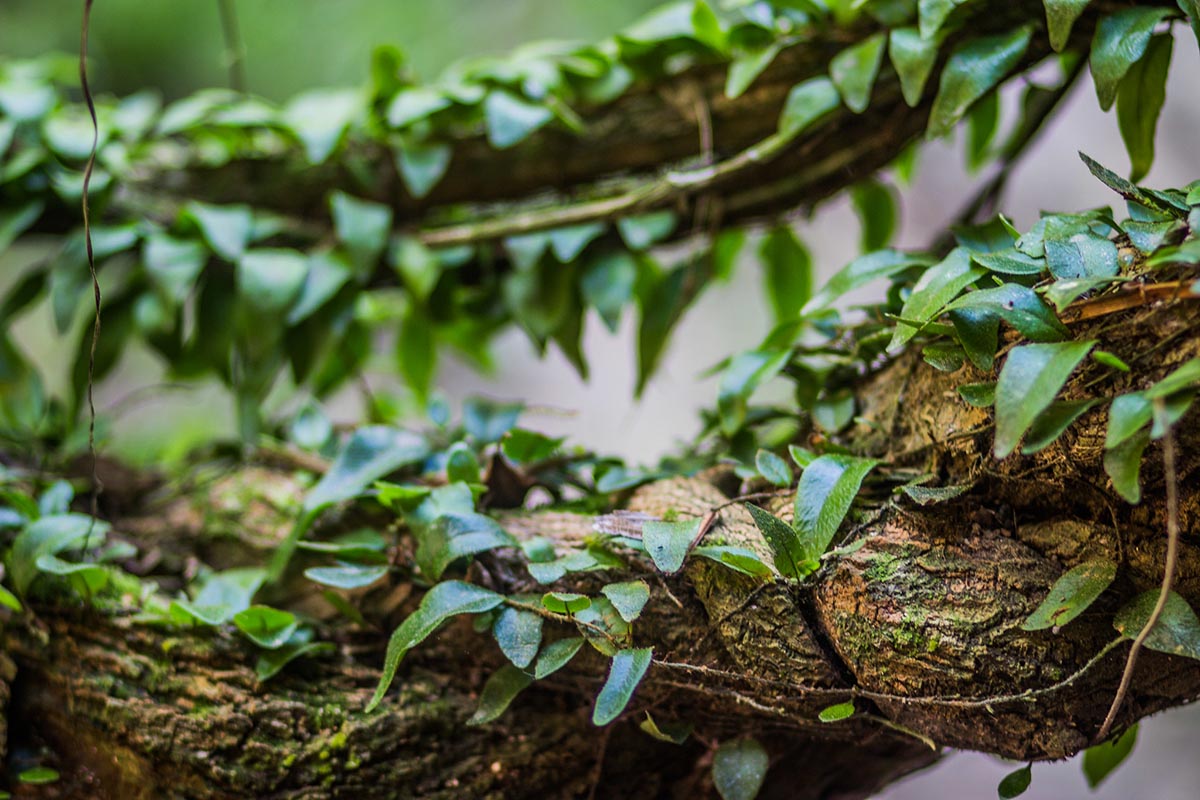
Vines used in an Ayahuasca brew in Iquitos, Peru. Ayahuasca Vine_10 by Apollo, used under CC BY-SA 2.0 / Cropped and compressed from original
During the mid-16th century, early Spanish expeditions ventured into uncharted rainforest in search of the fabled jungle city of gold: El Dorado. In northern Peru, the waterways they encountered didn’t lead them to El Dorado, but instead to the mighty Amazon River. It wasn’t long thereafter that the Spanish discovered that the Amazon River stretched all the way from the Atlantic Ocean into present-day Brazil, introducing an important trade route in South America.
Iquitos was inhabited long before it was officially founded in 1864. Local tribes have lived off of the lush ecosystem for centuries. It was the discovery of the Amazon Basin in 1541 that catapulted Iquitos city into establishment. Since then it has a history with Christian Jesuit missionaries gathering members of local tribes into groups or “Reducciones” in attempts at converting them to Christianity and a different style of living.
Over the next centuries and into the era of Peru’s declaration of independence from Spain in 1821, the importance of Iquitos grew. The city’s location in the heart of the Amazon Basin and easy river access was strategic for trade in an otherwise remote region.
Lasting from the 1880s through the early 1900s, was a period of intense growth for Iquitos. During this time, rubber was in high demand for making car tires in Europe and the United States. Opportunistic businesses (or rubber barrons) used the port city and forced help of the locals to export large quantities of the natural growing Amazonian product on steamships cruising the waterways.
Where does the rubber come from? Natural rubber comes from rubber trees that grow in the Amazon rainforest in Peru and South America. Under their bark is a soft tissue that’s rich with a creamy liquid called latex used for making rubber products.

Latex comes from rubber trees and is harvested from the trees into bowls. Natural rubber tree by DelwarHossain, used under CC BY-SA 2.0 / Cropped and compressed from original
Today, Iquitos is one of the biggest cities in Peru. With the Iquitos population including more than 400,000 people, it is the 6th most populated city in Peru. Tourism is an important driver of the Iquitos economy. Travelers arrive to the colorful Amazonian city by plane or boat, and venture deeper into remote tracts of rainforest where adventure and wildlife await.
Visiting the Amazon Rainforest makes for an unforgettable experience that for some travellers rivals Machu Picchu! Iquitos is a recommended addition to your Peru itinerary because it can cater to those looking for luxury, adventure, new health foods, or just looking to disconnect! While also found in Puerto Maldonado, Iquitos has the advantage for its special location of being on the iconic Amazon River.
Let us make your visit to the Peruvian Amazon effortless on your part! Easily customize your Peru itinerary with Iquitos if the Amazon River is a must-see on your way to Machu Picchu! Talk with one of our Travel Agents today!


Email: [email protected]
Sign up to receive our newsletter for great articles, stunning photos, and special deals.